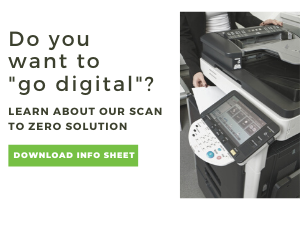Scan to Zero: Become a Paperless Office
Is your office full of boxes and file cabinets full of paper documents? If so, it’s probably because government regulations require businesses to save HR files, medical records, financial records, legal documents and other paper for years – 10 years in the case of medical records – on the off-chance they might be needed someday.
Many organizations devote valuable square footage of office space to storing hundreds, thousands or tens of thousands of boxes. The alternative is making monthly payouts to a third-party for storage. In either case, accessing a particular record could take days and, if you’re using an off-site storage service, cost you in retrieval fees.
‘Scan-to-Zero’ sounds like what it is. Put simply, it means scanning, digitizing and indexing all your stored documents until you’ve eliminated every box of physical paper and pay zero in storage costs. As a concept, Scan-to-Zero is relatively new and not particularly widespread – less than 10 companies nationwide actually use the term and provide the service.
That’s not to say companies haven’t been offering conversion services to digitize paper records for years – they have.
Scan-to-Zero, though, differs from traditional conversion in the way the scanning service is implemented. Here’s a typical scenario to illustrate:
- Company A has 300 boxes of paper documents stored at an off-site facility.
- Company A spends thousands of dollars every month in storage fees – a cost that only grows as it adds more boxes.
- Company A wants to eliminate those storage costs by scanning, digitizing, indexing, and classifying all of its documents.
- They call Company B, which offers both a traditional conversion service and a Scan-to-Zero service. In both cases, Company B tells Company A it’s going to cost $300,000 to scan, digitize and index all those documents.
- Company A’s CFO doesn’t have that kind of money in the budget for scanning and thinks she’ll have to cancel the project entirely.
- In a traditional conversion scenario, Company B would scan, digitize and index all 300 boxes as a single batch and present a bill for $300,000.
- In a Scan-to-Zero scenario, Company B would remove those 300 boxes from the off-site facility, store them at no charge and scan documents in smaller batches every month – over a period of years, if necessary. It will scan (x) number of boxes each month at a cost equal to what Company A was paying per month in storage fees until all boxes are eliminated. It’s cost-neutral.
- Of course, new paper documents are always being created; the flow doesn’t stop the moment all boxes are scanned and digitized. To avoid another buildup, Company A contracts with Company B to continue document scanning on an ongoing basis.
- Company A’s CFO is named Employee of the Month in recognition of a job well done.
In essence, Scan-to-Zero allows Company A to reallocate its monthly storage spend to a monthly scanning spend until all boxes have been eliminated, thus optimizing their document management budget.
After decades of talk about moving toward paperless workplaces, some might find it hard to believe that organizations still fill warehouses with boxes full of physical documents, but many still do. Regulatory compliance, inertia or the cost of digitizing all those records are potential reasons why. Scan-to-Zero, though, eliminates all those possible explanations as effectively as it eliminates those boxes. It makes going digital easy and cost-neutral, and it just plain makes sense.



